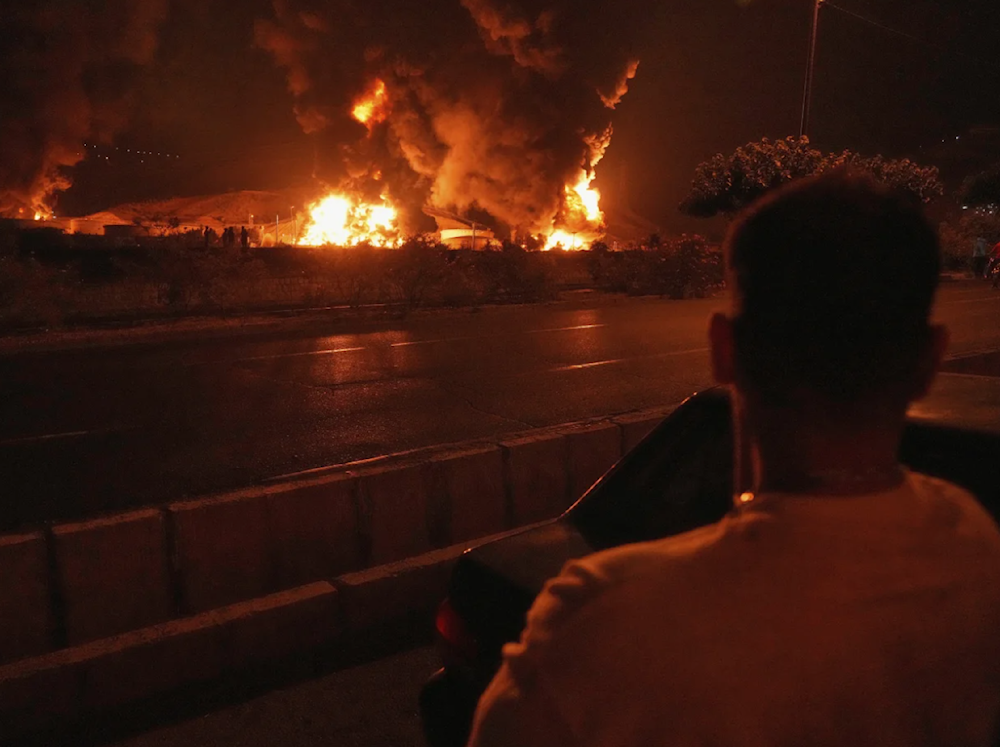IRGC announces martyrdom of intel chief, aides, in Israeli strike
The martyred commanders are the head of the Islamic Revolutionary Guard Corps Intelligence Organization, Mohammad Kazemi, his deputy, General Hassan Mohaqeq, and General Mohsen Bagheri.
-

A man looks at flames rising from an oil storage facility after it was struck by an Israeli strike in Tehran, Iran on June 15, 2025. (AP)
Iran's Islamic Revolution Guard Corps (IRGC) announced on Sunday the martyrdom of three Mujahideen intelligence commanders in a targeted attack on Iranian civilians in residential areas.
The martyred commanders are the head of the Islamic Revolution Guard Corps Intelligence Organization, Mohammad Kazemi, his deputy, General Hassan Mohaqeq, and General Mohsen Bagheri, who were killed as a result of the Israeli airstrikes targeting sites inside Iran.
In response, the IRGC announced that its Aerospace Force fighters had carried out a new wave of precision missile attacks targeting Israeli intelligence centers, as part of the third phase of Operation True Promise 3.
The statement concluded with a warning to supporters of the "criminal Israeli regime," stressing that "effective and targeted operations against the regime's vital targets will continue until its complete elimination."
On Sunday, al-Qassam Brigades, the military wing of Hamas, published a statement mourning the Iranian generals who were killed in the Israeli attacks on Iran.
In the statement, the brigades said, "With pride and great honor, al-Qassam Brigades mourn the Islamic Ummah's martyrs of the Islamic Republic of Iran, the senior commanders of the Iranian Armed Forces who were martyred as a result of the ongoing Zionist aggression against the Republic. At the forefront: Mohammad Bagheri, Chief of Staff of the Iranian Armed Forces, Hossein Salami, Commander-in-Chief of the IRGC, and Gholam Ali Rashid, Commander of Khatam Al-Anbiya Central Headquarters."
Iranian high-tech strikes breach Israeli air defenses: The Telegraph
Tehran fired more than 200 missiles at "Israel" on Friday and Saturday as part of its retaliation, many of which have penetrated "Israel's" renowned air defences, forcing the military to warn its people that the defenses were "not hermetic", according to The Telegraph.
According to The Telegraph, Iran's targets were not civilian areas, as circulated footage showed missiles landing in and around the Kirya compound, a compound belonging to the Israeli Ministry of Security and known as the Israeli Pentagon.
Another target struck early Sunday morning was the Weizmann Institute, a research hub in Rehovot near Tel Aviv, which overlaps between academic and military domains, as its work, though officially civilian, plays a significant role in Israeli defense technologies.
How did Iran's missiles punch through?
The Telegraph wrote that almost 10% of Iran's missiles have evaded "Israel's" complex air defense network, while highlighting that the IOF refused to provide a number to allegedly avoid offering Iran information it could use for future attacks.
The Iranian airstrikes underscore the challenges faced by even the most advanced air defense systems in countering ballistic missiles, which travel at hypersonic speeds exceeding Mach-5, leaving few surface-to-air missile batteries capable of effectively intercepting them.
"Israel's" "David's Sling" system is among the few capable of intercepting such threats, yet when confronted with simultaneous barrages of dozens of missiles, even this advanced system struggles to maintain full effectiveness.
The greater the volume of missiles launched, the higher the probability that at least one will evade interception and strike its target, with experts suggesting Iran is likely deploying the majority of its ballistic missiles to overwhelm and distract air defenses, thereby creating opportunities for a more sophisticated weapon to penetrate.

 3 Min Read
3 Min Read










